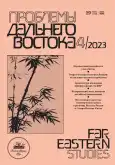The Inner Mongolia Autonomous Region in the Implementation of China's Educational Policy in Inner Asia
- Autores: Aktamov I.G.1
-
Afiliações:
- Institute for Mongolian, Buddhist and Tibetan Studies of the Siberian branch of the Russian Aacdemy of Sciences
- Edição: Nº 4 (2023)
- Páginas: 174-187
- Seção: Articles
- URL: https://journals.rcsi.science/0131-2812/article/view/142526
- DOI: https://doi.org/10.31857/S013128120027413-5
- ID: 142526
Texto integral
Resumo
Palavras-chave
Sobre autores
Innokentii Aktamov
Institute for Mongolian, Buddhist and Tibetan Studies of the Siberian branch of the Russian Aacdemy of Sciences
Email: pdvjournal@mail.ru
Sakhyanovoy str., 6, Ulan-Ude, Republic of Buryatia, Russian Federation
Bibliografia
- Батунаев Э.В., Григорьева Ю.Г. Российско-монгольские отношения: от спада до всеобъемлющего стратегического партнерства // Известия Восточного института. 2019. № 3. С. 98–109. DOI: dx.doi.org/10.24866/2542–1611/2019–3/98–109
- Гомбоев Б.О., Харимаева В.Г. Сбалансированное развитие пастбищного животноводства в степном комплексе районов Внутренней Азии: актуализация исследования природных, хозяйственных и культурных оснований // Вестник Бурятского государственного университета. Биология, география. 2023. № 1. С. 41–50. doi: 10.18101/2587–7143–2023–1–41–50
- Гулева, М.А., Ши Ш., Гао М. Развитие человеческого капитала в КНР // Проблемы Дальнего Востока. 2023. № 3. С. 175–190. doi: 10.31857/S013128120025967–4
- Гурулева Т.Л. Евразийское образовательное пространство России: предпосылки формирования и теоретические аспекты моделирования (на примере образовательного сотрудничества с КНР) // Современные проблемы науки и образования. 2015. № 5. С. 457–466.
- Двусторонние договоры. Правовой департамент МИД России // Официальный сайт МИД РФ. URL: https://www.mid.ru/ru/foreign_policy/international_contracts/international_contracts/2_contract/47900/ (дата обращения: 05.07.2023).
- Завьялова О.И. Языковая политика в Китае: новейшие полевые исследования // Проблемы Дальнего Востока. 2022. № 4. С. 160–167. doi: 10.31857/S013128120021422–5
- Резник Ю.Н., Гурулева Т.Л. Формирование международного поликультурного образовательного региона Сибири, Дальнего востока России и Северо-восточных провинций Китая // Вестник Читинского государственного университета. 2009. № 6 (57). С. 85–92.
- Семенова С.С. Образование в Китае: история и современность // Вестник ТГПУ. 2012. 5 (120). С. 126–130.
- Тарантул Р.В. Монгольский национальный фактор в КНР и китайско-монгольских отношениях // Проблемы Дальнего Востока. 2023. № 1. С. 36–52. doi: 10.31857/S013128120024367–4
- Хроника встреч глав государств Китайской Народной Республики и Российской Федерации // Китайский информационный интернет-центр. 10.12.2002. URL: http://russian.china.org.cn/russian/52942.htm (дата обращения: 05.07.2023).
- Хухбатор Б. Советский ученый Г.П. Сердюченко и литературный язык: исторические особенности развития литературного языка МНР и монголов Внутренней Монголии на основе архивных материалов 1950 х гг. // Вестник Бурятского научного центра Сибирского отделения Российской академии наук. 2021. № 1 (41). С. 48–60. doi: 10.31554/2222–9175–2021–41–48–60
- Энхбаяр Д. Трансформация системы образования Монголии // Власть. 2011. № 3. С. 96–99.
- 姜永志, 白红梅. 一带一路”倡议背景下中蒙俄民族教育智库建设:价值、困境与路径 (Цзян Юнчжи, Бай Хунмэй. Создание китайско-монгольско-российского образовательного аналитического центра в контексте инициативы «Пояс и путь»: значение, препятствия и перспективы) //民族教育文摘. 2023年. 第三期目录(总第二十五期). URL: http://epc.swu.edu.cn/info/1192/4493.htm (дата обращения: 05.07.2023).
- 中俄教育合作的历史 (История китайско-российского сотрудничества в сфере образования) // 汉斯留学. URL: http://www.hansiliuxue.com/h-nd-28.html (дата обращения: 01.07.2023).
- 中共中央 国务院关于建立更加有效的区域协调发展新机制的意见 (Отдельные тезисы Центрального комитета Коммунистической партии Китая и Государственного совета о создании нового более эффективного механизма регионального скоординированного развития) // 中华人民共和国中央人民政府. URL: https://www.gov.cn/zhengce/2018–11/29/content_5344537.htm (дата обращения: 22.07.2023).









